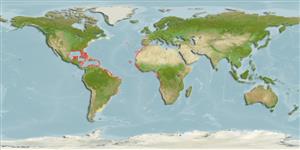Classificação / Names
Common names from other countries
Referência principal
Tamanho / Peso / Idade
Max length : 250 cm TL macho/indeterminado; (Ref. 2683); common length : 130 cm TL macho/indeterminado; (Ref. 2683); Peso máx. publicado: 161.0 kg (Ref. 26340); Idade máx. registada: 55 anos (Ref. 9975)
Length at first maturity
Lm 160.0, range 130 - 128.5 cm
Ambiente
; marinhas; Água doce; estuarina associadas(os) a recifes; anfídromo (Ref. 51243); intervalo de profundidade 0 - 30 m (Ref. 3789), usually 0 - 15 m (Ref. 42064)
Clima / Intervalo
Subtropical, preferred 26°C (Ref. 107945); 49°N - 44°S, 99°W - 14°E (Ref. 55254)
Distribuição
Atlantic Ocean: from Nova Scotia, Bermuda and southward to Brazil in western Atlantic Ocean (Ref. 3234, 4446), where it it also found throughout the Gulf of Mexico and the Caribbean (Ref. 26938); from Mauritania to Angola in eastern Atlantic Ocean (Ref. 2845, 3234, 4446, 81266); with exceptional records in Portugal, Azores and Atlantic coast of southern France (Ref. 3234, 4446). It had crossed the Panama canal and was also caught at Coiba Island in the Pacific Ocean (Ref. 4446).
Países | Áreas FAO | Ecossistemas | Ocorrências | Introduções
Descrição breve
Espinhos dorsais (total): 0; Raios dorsais moles (total): 13-16; Espinhos anais 0; Raios anais moles: 22 - 25; Vértebras: 53 - 57. Diagnosis: It is characterized by the anterior position of pelvic fin insertions in relation to dorsal-fin origin, and by some morphometric counts: 13-16 dorsal-fin rays, 40-48 lateral-line scales and 53-57 vertebrae (Ref. 2845, 81266).
Categoria na Lista Vermelha da IUCN (Ref. 115185)
Ameaça para o homem
Reports of ciguatera poisoning (Ref. 31172)
Utilização humana
Pescarias: espécies comerciais; Aquacultura: espécies comerciais; peixe desportivo: sim; Aquário: Aquários públicos
Ferramentas
Relatórios especiais
Descarregue XML
Fontes da internet
Estimates of some properties based on models
Phylogenetic diversity index
PD50 = 1.0020 many relatives (e.g. carps) 0.5 - 2.0 few relatives (e.g. lungfishes)
Nível Trófico
4.5 ±0.0 se; Based on diet studies.
Resiliência
Baixo, tempo mínimo de duplicação da população 4,5 - 14 anos (K=0.07-0.10; tmax=55; Fec>1 million)
Vulnerabilidade
Very high vulnerability (76 of 100)
Categoria de preço
